Attention Coaches and Recruiters:
Contact information for this student-athlete is on the video. US Sports Network has no direct contact with any of the student-athletes profiled
Angela Ziganshina College Soccer Recruiting Video, Class of 2021
Contact information for this student-athlete is on the video. US Sports Network has no direct contact with any of the student-athletes profiled
Angela Ziganshina College Soccer Recruiting Video, Class of 2021
Presented on US Sports Net by Game Planner Pro!
Enter Code USSports to save 10% off the annual subscription. For Football Coaches, By Football Coaches Learn More...
Enter Code USSports to save 10% off the annual subscription. For Football Coaches, By Football Coaches Learn More...
Soccer
is one of the most popular sports in the world, with a growing number
of soccer enthusiasts and players world-wide. Here's a closer look at
the components of fitness and suggestions to organize your
high-performance training.
Soccer (also known as "football")
is widely accepted as one of the most popular sports in the world, with
a growing number of soccer enthusiasts and players worldwide.
Despite this fact, strength and conditioning programs for soccer are often neglected or outdated. Except at the professional level, many athletes and coaches still focus only on skill development and endurance training (i.e. running), and ignore the other important elements of fitness such as:
In this article I will take a closer look at the different components of fitness involved in this sport, and then suggest a simple way to organize your high performance training program. I will not be discussing skill development in this article.
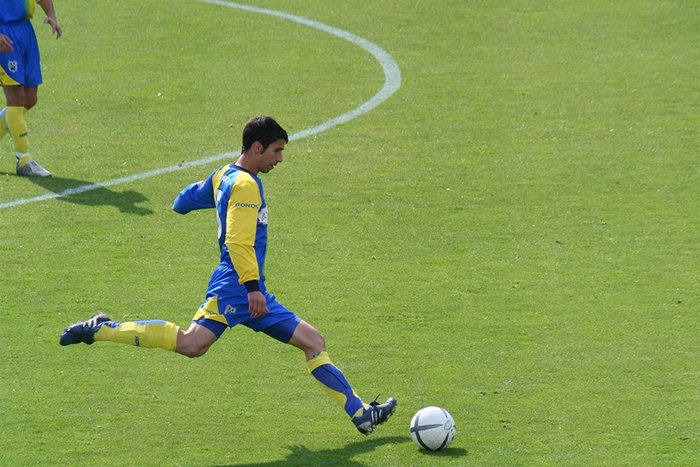
This places a significant demand on the athlete's cardiovascular
system and muscular endurance. Having said that, I believe this is one
aspect of training that is already over-emphasized in this sport.
It's not uncommon to hear of soccer players running for at least an hour at a time several days per week in an attempt to improve their performance on the field. However, if you start to analyze the 'sport-specific' requirements of the athletes, you will realize that they are actually engaging in varying intensities of activity for different durations while playing, including:
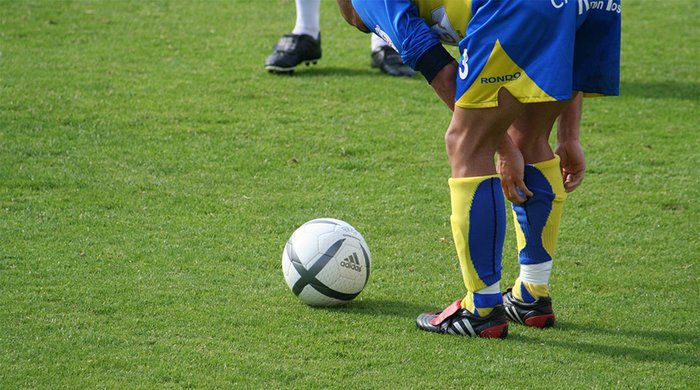 Your strength training program should focus on compound, functional
exercises (such as lunges, squats, step ups, pushups, dips, chin-ups),
and take into account balancing the strength of opposing muscle groups
(i.e. quadriceps vs. hamstrings).
Your strength training program should focus on compound, functional
exercises (such as lunges, squats, step ups, pushups, dips, chin-ups),
and take into account balancing the strength of opposing muscle groups
(i.e. quadriceps vs. hamstrings).
Don't waste your time training solely on machines, and avoid useless, non-functional exercises such as leg extensions. The majority of your exercises should be ground-based, using bodyweight or free weights as resistance, and should involve movement of your full body.
Train all the major muscle groups, with emphasis on lower body and core.
A simple speed test is a sprint more than 30 yards from a standing start. You can try this yourself and have someone else time you. A sprint time under 5.0 seconds is good. Professional players average around 4.0 seconds.
Power is the combination of strength and speed. A more powerful player is a more formidable player. To improve your speed and explosiveness you should include power movements in your program, such as jump squats, high pulls, power cleans, and push presses, as well as plyometric drills .
Because it is important to have speed endurance, I recommend incorporating these exercises into a circuit training program with high intensity intervals. A typical workout would alternate between power movements for lower body and upper body, with plyometric exercises as intervals. You can conclude your training session with sprint drills and agility work (such as the 'ladder drill').
 The safest and most productive way to integrate flexibility training
into your routine, is to do a dynamic warm-up (walking lunges,
bodyweight squats, high knees, butt kicks, arm circles, etc.) before a
workout, practice or game, and then spend some time stretching at the
end.
The safest and most productive way to integrate flexibility training
into your routine, is to do a dynamic warm-up (walking lunges,
bodyweight squats, high knees, butt kicks, arm circles, etc.) before a
workout, practice or game, and then spend some time stretching at the
end.
Also, a better alternative to static passive stretching is static 'active' stretching (using your own muscular effort to hold the position). Read my article "Stretching: The Long and Short of It" for more information.
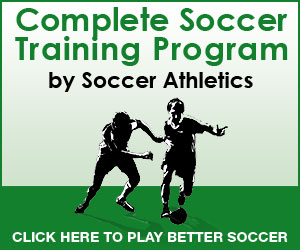
Do some agility work and sprint starts at the end of your speed/power circuit. Then include 2-to-3 endurance/cardiovascular training sessions each week as well, running for about 30 minutes with short sprint intervals and hill running ... not just long endurance runs.
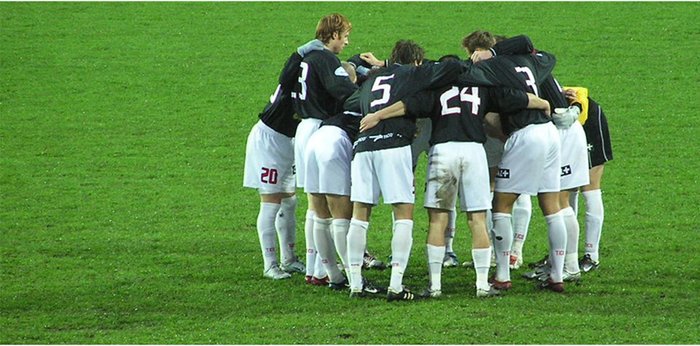 Adjust Your Training Depending Upon Practices Or Games.
Adjust Your Training Depending Upon Practices Or Games.
I expect that you have found this article informative and that I have adequately explained why serious soccer players need to follow a sport specific conditioning program. My hope is that this will help you reach your athletic goals by training like a pro!
Despite this fact, strength and conditioning programs for soccer are often neglected or outdated. Except at the professional level, many athletes and coaches still focus only on skill development and endurance training (i.e. running), and ignore the other important elements of fitness such as:
- Strength and strength endurance training
- Speed and power
- Flexibility, warming up and cooling down
- Agility training
- Nutrition
In this article I will take a closer look at the different components of fitness involved in this sport, and then suggest a simple way to organize your high performance training program. I will not be discussing skill development in this article.
Endurance In Soccer
A soccer fitness program should be built around developing a good aerobic base. Several studies into the physiological demands of soccer have shown that outfield players can travel up to 13 km or 8 miles during a 90-minute game.
Outfield players can travel up to 13 km or 8 miles during a 90-minute game.
It's not uncommon to hear of soccer players running for at least an hour at a time several days per week in an attempt to improve their performance on the field. However, if you start to analyze the 'sport-specific' requirements of the athletes, you will realize that they are actually engaging in varying intensities of activity for different durations while playing, including:
- Walking
- Jogging
- Running
- Sprinting
- And in various directions.
Strength In Soccer
Strength is an important component of fitness that can benefit athletes in any sport, although it is often viewed as of little importance in soccer. However, strength forms the basis for power and speed. Soccer players also need strength to hold off challenges from opponents. Other benefits of strength training include:- Injury resistance
- Leaner body composition
- Faster metabolism
- More energy
- Greater explosiveness
- Improved balance, stability, and agility
- Faster recovery

Don't waste your time training solely on machines, and avoid useless, non-functional exercises such as leg extensions. The majority of your exercises should be ground-based, using bodyweight or free weights as resistance, and should involve movement of your full body.
Train all the major muscle groups, with emphasis on lower body and core.
Speed and Agility In Soccer
Another significant component of a soccer fitness program is speed and agility training. The speed of play in today's game is quicker than ever. While endurance and strength are very important to improving your performance, faster players have a definite competitive edge. You may have better endurance than the next guy, but if he makes it to the ball first it won't matter that you can run marathons!A simple speed test is a sprint more than 30 yards from a standing start. You can try this yourself and have someone else time you. A sprint time under 5.0 seconds is good. Professional players average around 4.0 seconds.
Power is the combination of strength and speed. A more powerful player is a more formidable player. To improve your speed and explosiveness you should include power movements in your program, such as jump squats, high pulls, power cleans, and push presses, as well as plyometric drills .
Because it is important to have speed endurance, I recommend incorporating these exercises into a circuit training program with high intensity intervals. A typical workout would alternate between power movements for lower body and upper body, with plyometric exercises as intervals. You can conclude your training session with sprint drills and agility work (such as the 'ladder drill').
Flexibility In Soccer
Another important aspect of fitness to discuss is flexibility. Maintaining a healthy range of motion can be beneficial, however, few people understand the most effective methods of stretching or when to use them. Many athletes still do passive stretching before their workout or practice, when actually this can diminish performance and increase risk of injury!
Also, a better alternative to static passive stretching is static 'active' stretching (using your own muscular effort to hold the position). Read my article "Stretching: The Long and Short of It" for more information.

Nutrition For Soccer
I won't get too deep into the subject of sports nutrition here ... that's a whole other article. Suffice it to say that what you eat will directly effect your energy levels, recovery, performance and health. Here are some basic tips to consider regarding your diet:- Drink A LOT more water.
- Eat 4-6 smaller meals / snacks each day.
- Eat after exercise, not directly before.
- Each meal should include: Protein, fuits and vegetables, Whole grains
- Starchy carbs (i.e.: pasta, potatoes, rice, bread, grains, etc) should be eaten after exercise, or the night before a big game, but otherwise reduced in your diet.
- No sugars, pastries, junk food, pop, chips, alcohol, tobacco, etc.
- Don't eat before sleep.
- Take fish oil daily.
The Program
Here is a simple way to organize your training, on and off the field:Off Season:
Your off-season weekly gym program should include two strength training days (superset opposing muscle groups using functional exercises) and a speed/power day (explosive weightlifting movements in a circuit, with plyometrics as intervals), in addition to your athletic skill training/practices on the field.Do some agility work and sprint starts at the end of your speed/power circuit. Then include 2-to-3 endurance/cardiovascular training sessions each week as well, running for about 30 minutes with short sprint intervals and hill running ... not just long endurance runs.
In Season:
For in season training, just reduce your training volume and cut back to only one strength workout and one speed/power workout per week. You can adjust the number of endurance training sessions as well, depending on the number of practices or games you have each week.
Conclusion
Keep in mind that this is only a basic overview of high performance training for soccer. For a complete program design, and detailed explanation of these exercises, go to www.SoccerAthletics.com. It is a complete and comprehensive resource for soccer athletes. If you are in the Toronto area, you can contact me regarding group high performance training. Also check out my other related articles at: https://goto.bodybuilding.com/5NDB9.I expect that you have found this article informative and that I have adequately explained why serious soccer players need to follow a sport specific conditioning program. My hope is that this will help you reach your athletic goals by training like a pro!
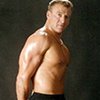
Josh Hewett
Josh Hewett is a personal trainer and strength and conditioning specialist with Top Form Fitness. He also coaches
and competes as a strongman.




No comments:
Post a Comment